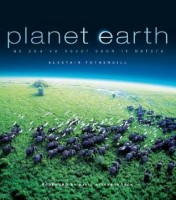 Title: Planet Earth: As You’ve Never Seen It Before
Title: Planet Earth: As You’ve Never Seen It Before
Author(s): Alastair Fothergill, Vanessa Berlowitz, Mark Brownlow, Huw Cordey, Jonathan Keeling
Release year: 2006
Publisher: BBC Books
Why in Database: A complementary book to the tv nature series with the same title . There are only few turtle fragments, actually only minor references plus one (full-page) graphic.
The first mentionis about, the Amazon River:
Other oversized predators include the world’s largest freshwater dolphin, otter and river turtle and the green anaconda, which can grow to more than 6m (20 feet) long.
Second fragments is about Jaguars diet:
(…) capable of klling large mammals, but its normal prey animals are small – anything from turtles to peccaries (small pigs).
Another mention is about “underwater meadows”:
A whole community of detritus feeders and herbivores depend on the seagrass for their food – sea urchins, turtles and een some parrotfish graze the beds, and many tiny creatures live on and arround their leaves.
The next fragment is a description of the photography:
A baby green turtle sheltering in sargassum weed.
Fragment about Nekton, “things” that can move by itself in water and are not dependent on the current:
(…) and they include most of the fish, squid, marine mammals (dolphins, whales, seals and so on), turtles, seas snakes and even penguins.
The last fragment is about diving:
For instance, the only deep-diving turtle is the leatherback. Most marine turtles have rigid shells, but the leatherback has a flexible shell that allows it to survive the changing pressure. Even so, leatherbacks only make quick foraging trips down to 500m (1640 feet) and back in just 10 minutes.

Author: XYuriTT
